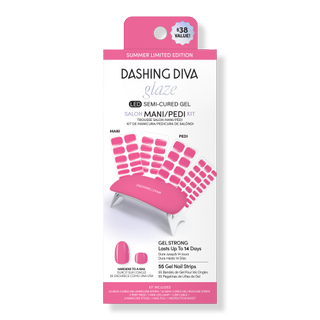Like Jaws before it, the release of Cocaine Bear earlier this year has resulted in a slew of natural horror films, many of which are using the same conceit of an animal driven to extreme behavior by the consumption of narcotics. Projects already in production include Crackcoon and the delayed Methgator, created by The Asylum. You can probably guess their plots.
One animal-on-drugs movie that has already seen release is Cocaine Shark. Whereas that film treated its subject matter with an unabashedly schlocky approach, though, the more recent Deep Fear takes a similar gimmick and plays it with a straighter face. It could be the perfect post-summer movie for anyone who wants a fun cinematic trend taken a little more seriously.
Set on a yacht sailing around Grenada, Deep Fear centers on a woman named Naomi (Mãdãlina Ghenea) who, during a sailing trip to see her boyfriend (Ed Westwick), gets caught up in a plot involving sharks, a shipwreck, and 350 kilograms of white powder. Intrigued, Bloody Disgusting checked in with director Marcus Adams about the film’s tone, the current natural-horror boom, and his own experience with sharks and the ocean.
What’s your personal history with sharks? Have you ever seen one in the wild? Are you scared of them?
I lived in South Africa for two years, post-Jaws. A fisherman once caught a young shark right next to where I was surfing. It was a natural element that everyone accepted because the ocean was too beautiful to resist. There were shark nets in the main urban swimming areas—for instance, Durban Beach. However, even when swimming in non-netted areas, attacks were extremely uncommon.
How did Robert Capelli Jr. and Sophia Eptamenitis’ script for Deep Fear come to you? Did you know them beforehand or have any influence on the story?
I did not. The bones of the story were there on the page when producer Sean O’Kelly introduced me to the script. In essence, it was a sailor picking up people from a wreck, and then matters turning for the worse. The balancing act for me as a director was fusing a narco story with a shark story. If you get it wrong, you do not satisfy either genre strand. I felt the shark, not the narcos, had to be the star, and that was chiefly my input to the script development process. Decide who or what element is on the poster, then work backward from there.
Even before Cocaine Bear, there have been a ton of wacky modern shark films on Syfy over the past decade or so, none of which take themselves too seriously. With Deep Fear, did you set out to make something that’s just plain fun in the vein of Sharknado, or did you want to take a more sober and realistic approach?
As the character was inherently real—a sailor (there are no scientists in the film tampering with shark DNA or the like)—the tone had to remain set within reality. Tone in movies is probably one of the most important and sometimes difficult elements to distinguish. You still need some light relief, even if the subject matter is serious. Jaws did it with Dreyfuss, Shaw, and Scheider drunkenly singing “Show Me the Way to Go Home”, only to be somewhat rudely interrupted by the shark, as it smashed into the side of the boat. That’s genius editing and structure.
With the success of Cocaine Bear, we’re seeing an uptick in natural horror movies involving an animal ingesting some kind of substance. What are some other beasts you’d like to see in this subgenre?
Cocaine Zombies.
Deep Fear is already a pretty intense and revved-up movie. How would you make things even bigger and badder for a sequel?
More money = more shark = bigger set pieces = more revved up.
When it comes to natural horror or, more specifically, shark movies, are there any different strategic approaches you have to take as a director? How does the game plan differ from, say, a slasher movie?
When making a feature starring a creature, as a filmmaker, you are restricted/governed by the laws of physicality surrounding that specific animal. Animals, especially sharks in water for instance, have ultimate super-skills compared to us. They can naturally do many things that we as humans cannot. However, they lack the intellect of a human. So it’s invariably brains vs. brawn.
A slasher movie, on the other hand, is an almost more difficult map to navigate, especially regarding set pieces, because it’s very hard to outwit a knife-wielding psycho, both for the victim and the filmmaker. The nemesis is usually more physically able than the victim, and they are usually armed, with the same level of intelligence. So when choreographing the set pieces of a slasher, the chances of survival for the victim very quickly run out. If they continue to outwit the nemesis, the film risks implausibility. How often have we all groaned at moments where implausibility strikes and we are momentarily sucked out of the movie?
Did you and your team conduct any research on how a shark would actually respond to cocaine? If so, how did this inform the film? Any interesting takeaways?
We did have some fun conversations. One was that maybe the shark suffered the shark equivalent of “brewer’s droop” (aka erectile dysfunction)—a “floppy fin”! The other was that the shark would forget hunting our lead actress, go back to his yard, and talk shit all night with his mates.
Did you use any real shark footage in the film, or was it entirely digitized?
It’s a 90/10 percent split favoring CG. When you watch the film, see if you can spot the real versus the digital.
What are the challenges in directing horror scenes with a digital animal? How do you ensure the cast can convincingly be scared of something they can’t yet see?
Imagination is a prerequisite part of any actor’s armory. You have to trust the actor’s ability to deliver. As a director, I had to give clear timings and directions for looks and turns, shrieks and yells. We also had a plastic shark head on a pole that a diver was swimming with, which was especially good for when physical interactions were required.
Jaws remains the undisputed golden standard of shark movies. Where were you when you first saw it, and what was your reaction to it?
I was living in Durban, South Africa, swimming in shark-infested waters at the time. My initial reaction was that I knew the “swimming in the sea” experience had changed forever. Spielberg planted sharks at the forefront of our minds. The threat of a shark attack has always been at the back of our consciousness, and Spielberg irreversibly transported it to the front. I also felt that Jaws had single-handedly redefined movies forever. It’s still an utter masterpiece.
Do you believe super-sized great white sharks such as megalodons could still exist, somewhere in the depths of the ocean?
Why not? No one really believed Trump would become president, and he did. Fucked-up, scary shit actually happens. Monsters exist!
Deep Fear is now available to rent via Amazon Prime.


























































![Mason Ramsey – Twang [Official Music Video] Mason Ramsey – Twang [Official Music Video]](https://i.ytimg.com/vi/xwe8F_AhLY0/maxresdefault.jpg)
























